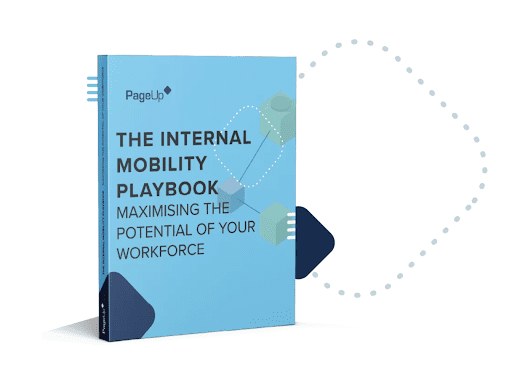When you’re looking to address skills gaps or fill roles, your first instinct might be to look externally for qualified talent. But what about the untapped talent that already exists in your organisationorganization?
Leading talent acquisition teams are leveraging the power of internal talent mobility.
What is internal mobility?
Internal mobility is defined as the vertical or lateral movement of employees across different roles within a company. Internal mobility is used for career development, employee engagement, and to fill skills gaps.
What are the main benefits of internal mobility?
Internal mobility benefits employees, talent acquisition teams and organisationsorganizations by providing visibility of skills, establishing clear career paths, and boosting retention.
The benefits are clear:
- Internal mobility is one of the most effective sourcing channels, according to PageUp research. It takes just 4 applications via internal mobility to result in 1 successful hire. Compare this to job boards, where it takes 36 applications to result in 1 hire.
- Employees at companies with high internal mobility stay almost twice as long as those with low internal mobility.
- Creating an internal mobility program allows you to understand the skills sets available in your existing talent.
- You can build deep pipelines of internal talent to be leveraged whenever a role arises.
- Boost employee retention by offering clear career development paths and exciting opportunities.
- You’ll be better positioned to pivot, innovate and adapt to challenges.
- You can slash cost per hire but avoiding expensive external attraction costs
Let’s explore the key benefits of internal mobility, how to build an effective program, and ways to measure return on investment.
Fill urgent skills gaps
One of the most pressing challenges businesses face today is a skills shortage that’s rapidly worsening. 87% of executives say they’re experiencing skills gaps now or expect them within a few years.
The good news is that internal mobility is gaining traction in response to this challenge. 67% of CEOs recogniserecognize reskilling as an ongoing responsibility. The majority believe this is particularly important for employees whose tasks and jobs are automated by technology.
Upskilling internal team members creates an invaluable source of ready, pre-qualified, culturally-aligned talent. It’s a direct route to faster candidate pipelining and time to productivity.
Increase employee engagement and retention rates
During the height of the pandemic, amidst stand downs and hiring freezes, we saw businesses upskilling and redeploying people. This was a great strategy to retain top performers.
It’s not just during tough times when internal mobility makes a difference. It works during “business-as-usual” times too.
According to LinkedIn’s Workplace Learning Trends report, people leave organisationsorganizations because of a lack of clear growth pathways, learning opportunities and new challenges. Internal talent mobility puts you in a better position to engage your current employees and avoid unnecessary turnover. According to SHRM, employees who are promoted within three years of being hired have a 70 percent chance of staying onboard. Those who make a lateral move have a 62 percent chance of staying.
Attract top talent
Internal employees enjoy the benefits of professional development opportunities and pathways for progression the same way external candidates do. Internal mobility boosts your employer brand and makes your organisationorganization more attractive to potential jobseekers.
Gain strong return on investment
Internal mobility allows you to recruit for less by building strong internal talent pipelines. With a pool of pre-vetted talent to draw from, you’ll spend less time and money on expensive external sourcing.
Even better, you’ll be able to avoid new starter turnover. Because internal hires have relationships with people in your company, they are already aligned with your values and culture. It’s much less likely they’ll leave within their first few months.
Survive challenging times
Over the past few years, we’ve experienced unprecedented disruption. There’s been a global pandemic, and an overnight shift to remote work models. We’ve had to adjust to emerging technologies and ways of interacting. The way we work will continue to evolve. Internal mobility strengthens organisationalorganizational resilience as change continues at an accelerated pace.
Internal hiring gives you greater capabilities to face disruption, stay agile and become more adaptable. You’ll be able to quickly respond to challenges, leverage skills and save recruitment time and costs.
Support transparency, diversity, equity and inclusion
By creating an inclusive internal mobility strategy, you’ll engage and develop your diverse internal talent, instead of losing them to competitors.
How do you build an internal talent mobility program?
Creating a successful internal talent mobility program can seem like a big task, but it doesn’t have to be. If you’re not sure where to start, here are a few simple steps you can take to make the process easier.
1. Create a business case for internal mobility
Recruitment teams already recogniserecognize the benefits of internal mobility as a critical talent acquisition strategy. It improves your employer brand, retains your top professionals and helps you be more strategic about recruitment. But what if you need to win over other business decision-makers who aren’t aware of its benefits?
First, build a business case by linking your program to recruitment metrics and bottom-line savings, primarily:
- Reduced recruitment costs – How much will you be able to scale back on recruitment advertising by looking within? A strong employer brand and culture will position your organisationorganization to both attract external talent and retain existing talent. It’s faster, more efficient and less expensive.
- Reduced turnover costs – Internal hires have existing relationships in your company and are connected to your culture and values. Internal mobility reduces recruitment and replacement costs – particularly the high risk associated with new starter turnover. (HR industry studies reveal the greatest staff turnover often happens within the first 45 days of employment.)

Internal mobility by the numbers.
The value of internal mobility comes from its ability to create more loyalty between employees and employers. By investing in an employees’ career journey, you’re telling them that they are a valued member of your organisationorganization. (Read more about avoiding the “doom loop”, where lack of company loyalty results in poor retention rates.)
What does a successful internal mobility program look like? Employers develop learning and development programs to upskill staff and fill future skill gaps. Employees gain skills for promotion and career growth. They stay with their employer, which strengthens the company’s overall employer brand, and encourages fresh talent to apply.
2. Develop a purpose, strategy and objects
Creating a plan will ensure your internal mobility program meets the criteria for success. Map out the skill sets that already exist in your company, as well as critical areas that require upskilling.
Build a cross-functional team to ensure your program runs smoothly throughout the organisationorganization. This team might include talent acquisition, learning and development, hiring managers and other stakeholders.
During this stage, the most important thing is to gain buy-in from hiring managers, C-Suite stakeholders and employees. A lack of buy-in can be one of the biggest barriers to a successful internal mobility program. “Talent hoarding” managers unwilling to lose their star performers can slow down even the most motivated HR teams.
3. Choose the right technology
The right recruitment marketing technology can make all the difference in ensuring your internal mobility program is a success. A robust platform should give you the ability to connect employees to job opportunities while still delivering a personalisedpersonalized, engaging experience.
Use recruitment marketing technology to:
- Engage your existing talent – Build internal landing pages with compelling calls-to-action that encourage employees to join talent networks, employee groups and mentorship groups. They can also submit expression of interest forms and sign up for job alerts.
- Tell your internal mobility story —Employee-generated content tools can help employees to share their internal mobility experiences, answer frequently asked questions from other employees, and share photos, videos and more.
- Build employee profiles —Encourage employees to share their aspirations and skill sets. This will allow you to deploy talent and connect individuals with roles, depending on business needs.
- Use automation —Attract, inform and engage employees through automation features, such as nurture flows and smart talent pipelines. You can also automate workflows, job alerts and communication.
- Manage content —Easily update internal job listings and landing pages. You can highlight your employee value proposition (EVP), learning content, employee career stories, and diversity, equity and inclusion (DEI) approach to internal mobility.
- Assess analytics —Measure the effectiveness of your efforts, address talent gaps and potential bottlenecks, and demonstrate return on investment. Assess employee traffic on your landing pages to promote more of the content people are engaging with.
Technology like PageUp Clinch recruitment marketing solution naturally embeds internal mobility in your organisationorganization. Use technology to gain a timely picture of employee career goals and skill sets, automate “busy” work, and measure success.
4. Engage employees
After developing your program plan, implementing technology and building out landing pages, it’s time to encourage employees to register and submit their profiles.
Promote these pages via internal emails and an internal careers site. You may even like to share a link to your internal mobility careers site on social media to amplify your employer brand.
Once your employees are registered for your internal mobility program, engage them with targeted content about careers, learning pathways and upskilling opportunities. Use information from employee profiles to target specific talent groups.
Embed your program into everyday operations. Set key performance indicators for managers to fill open positions with internal talent, and for employees to complete their profiles with up-to-date information.
Review the internal mobility program regularly with your cross-functional team and stakeholders to ensure it’s meeting your success criteria.
Want more information? Download PageUp’s complete, step-by-step guide to building an internal mobility program. Execute an effective program that cuts recruitment costs, keeps valued employees engaged, and fills critical skills gaps in your organisationorganization.
How can you measure return on investment?
Recruitment, retention and internal talent mobility are closely linked. When you invest in career pathways and promotion opportunities, you’ll engage and retain your top performers.
Analysing the data will help you understand what’s working and what isn’t. What content is resonating? Where are the skill gaps in your organisationorganization? What internal roles are proving to be the easiest to fill —and the hardest? Take action accordingly.
Measure outcomes against the success criteria you created before launching the program. This might include:
- Percentage of roles filled internally
- Number of internal hires per team (identify bottlenecks: this could indicate talent-hoarding managers)
- Diversity and inclusion-related metrics
- Retention rates
Review how many successful internal hires you make and the size of your internal talent pipelines. Continue to map skill sets and forecast future skills gaps.
Ideally, talent acquisition will split their time between recruitment marketing, promoting your employee value proposition to attract passive candidates, and developing internal mobility pathways.
Make your program a success by gaining company-wide buy in, determining a strategy and implementing the right recruitment marketing technology. Use analytics to continue growing your program, measure success and demonstrate return on investment.
Internal mobility is a key pillar of an effective talent strategy, delivering broad, long-reaching benefits and allowing you to fill urgent skills gaps.
Equip your organisationorganization with the workforce you need for the future. Use internal hiring as one of your greatest sources of talent.
Download our free, step-by-step guide to building an internal mobility program.
If you’d like to learn how PageUp can support your internal mobility program, get in touch today to request a demo.
Fresh insights for HR
Stay up to date with HR trends, tips and more when you sign up for our industry newsletter






